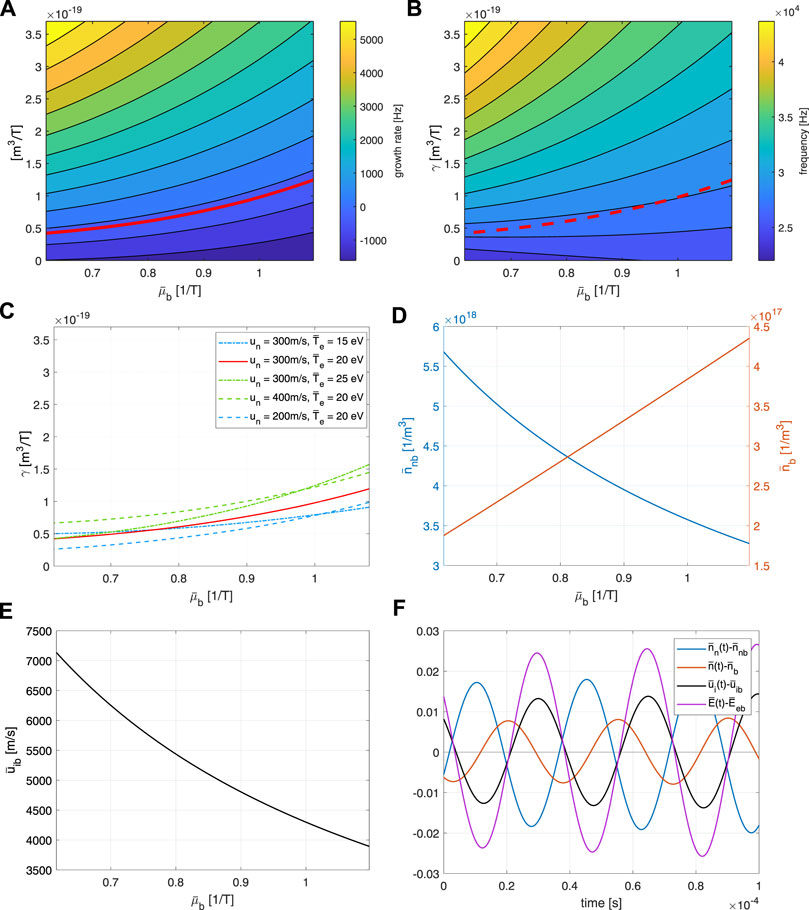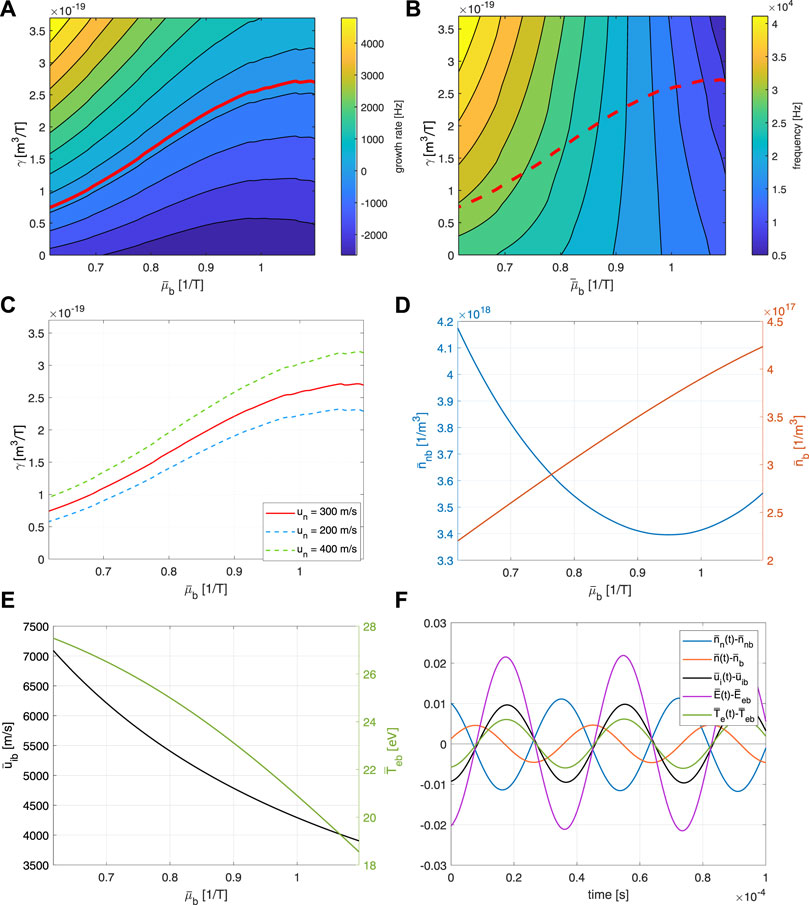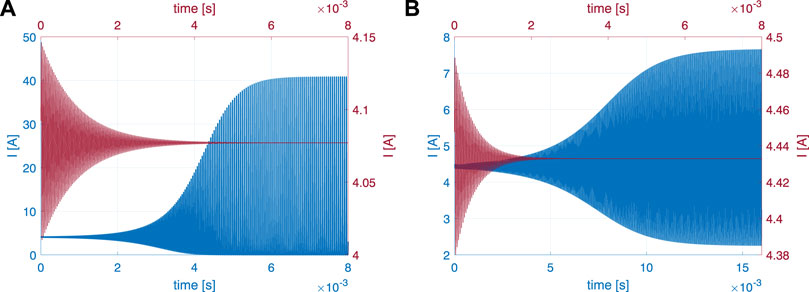
94% of researchers rate our articles as excellent or good
Learn more about the work of our research integrity team to safeguard the quality of each article we publish.
Find out more
BRIEF RESEARCH REPORT article
Front. Phys., 05 January 2023
Sec. Low-Temperature Plasma Physics
Volume 10 - 2022 | https://doi.org/10.3389/fphy.2022.1097813
The breathing mode is an instability typical of Hall thrusters, which is characterized by oscillations of the discharge current with amplitude of the order of its mean value and frequency in the 5–30 kHz range. The strong link between this instability and the ionization processes is generally recognized. If, on one hand, 1D simulations have shown to be able to reproduce the breathing mode, on the other hand 0D models fell short in recovering self sustained oscillations, making it hard to identify the core physical mechanism governing their formation. In this work an original 0D model is presented and characterized by means of linear stability analysis and direct numerical integration. The electric field is allowed to vary in response to variations of the neutral density, acting on the ionization rate via the electron temperature and the ion dynamics. It is shown that the model is able to reproduce self-sustained oscillations with the typical characteristics of the breathing mode, even when fluctuations of the electron temperature are neglected. The stability of the model is strictly determined by the rigidity with which variations of neutral density reflect into variations of electron mobility.
Hall thrusters are plasma-based electric propulsion devices for space applications featuring an E × B configuration that allows for the efficient ionization and acceleration of the gaseous propellant. For additional details on the design and operating principle of Hall thrusters refer to Ref. [1]. The strong coupling between the ionization and acceleration processes in these devices is associated with high amplitude, low frequency (5–30 kHz) oscillations of the discharge current and of the plasma properties, commonly referred to as breathing mode. Breathing mode is found ubiquitously in Hall thrusters, at least for some operating conditions, and appears to be a general feature of E × B discharges. Nevertheless, the specific characteristics of the oscillations vary greatly with the thruster design and operating condition [2, 3]. The presence of this oscillatory mode has detrimental effects on the thruster performance and can cause coupling issues with the driving electronics. Therefore, several experimental and theoretical efforts have been dedicated to the characterization of this oscillatory mode and to the determination of the feedback mechanism leading to its onset.
From the experimental perspective, intrusive and non-intrusive diagnostic systems have been employed to study the plasma dynamics in the thruster during oscillations [4–6]. The results show that breathing mode manifests as coherent longitudinal waves in the plasma, propagating in the channel and near plume without significant frequency dispersion. From the modeling point of view, breathing mode has been investigated with models of varying degree of complexity. Zero-dimensional formulations, originating from the work by Fife et al. [7], have demonstrated a similarity of breathing oscillations with predator-prey type instabilities, where the neutral population plays the role of prey while the electrons predate on them through ionization events. More complex formulations of the same system were proposed, including additional effects such as the neutral inflow density, the plasma-wall interaction, and the evolution of the electron temperature [8]. Nevertheless, the proposed 0D models could not reproduce self-sustained oscillations [9]. On the other hand, higher order formulations, such as multi-zone [10, 11] and 1D models (see, for instance [9, 12]), have demonstrated to be able to reproduce sustained oscillations with the typical features of the breathing mode. However, there is still no consensus about the stability criteria for its onset and growth.
In [13] a novel mechanism for the generation of breathing mode is identified by means of a three-species (neutrals, ions, electrons) 1D model of the plasma discharge in Hall thrusters. The model employs well established simulation techniques and is calibrated against a reference experimental configuration, as detailed in [12]. The analysis proposed in [13] focuses on both the linearized dynamics around the steady solution and on the non-linear behavior of the model. It is shown that the instability can be observed even if the electron mobility is linearized with respect to the neutral density, which implies fluctuations of the electric field in phase opposition with the oscillations of the neutral density. Two possible feedback mechanisms are proposed that may concur to the onset of breathing mode. The first one (E1), often considered in the literature, relies on the feedback produced by the oscillations of the electron temperature induced by the electric field, leading to variations in the ionization rate that sustain the instability. A second mechanism (E2) is also proposed, based on the observation that the oscillations of the electric field establish a positive feedback on the ionization rate also via the subsequent ion dynamics, through variations of the plasma density and regardless of the electron temperature. Indeed, the results of [13] show that fluctuations are observed also when the electron temperature is assumed to be stationary, indicating that the electron energy dynamics can influence the instability but is not necessary for its onset, at least in the investigated case.
In this work, a 0D model is proposed to further support the identification of the original feedback mechanism E2 highlighted above. The proposed 0D formulation is based on the 1D model and on the related results detailed in [13]. Unlike the one-dimensional case, in the 0D model the spatial gradients of the plasma properties are not resolved, and the focus is on the global behavior of the plasma in a control volume delimited by the anode and channel exit sections, and the lateral walls. We show here that it is indeed possible to formulate such a reduced-order model and that it can reproduce the main features of the breathing instability when the sole ingredients required for the identified feedback mechanism are included.
The proposed 0D model is built on the basis of the 1D model detailed in [13]. The magnetic field is assumed to have a dominant radial component, which is representative of the magnetic field topology in conventional Hall thrusters. In order to formulate the algebraic form of the related 0D model, an integral form of the 1D equations reported in [13] is derived here. By integrating over a volume of length L enclosed between the anode (A) and channel exit (C), we obtain:
where nn and n are the neutral and plasma densities, un is the neutral velocity, which is considered constant and uniform, ui is the ion velocity, ue is the electron velocity, Te is the electron temperature, E is the electric field, kI is the ionization rate,
The electron mobility μ is linearized as in [13], i.e.,
where the subscript b indicates the value taken at base state, which is the steady state upon which breathing may develop and which is identified as a steady solution of the model. γ in Eq. 6 plays the role of a rigidity coefficient for μ with respect to nn. Both μb and γ in Eq. 6 are functions of the radial magnetic field intensity and the plasma properties (nnb and Teb) evaluated at the base state.
The following fundamental assumptions are made in passing from the original integral equations to the 0D model. Neutral and plasma densities, ionization rate, electron temperature and electron mobility are assumed uniform inside the control volume, while electron and ion velocities are assumed to vary linearly. We also assume that the current is carried only by electrons at the anode and only by ions at the channel exit section, thus, uiA = ueC = 0,
where
In the previous equations, α is a coefficient modulating the plasma-wall interactions [12], ΔR is the channel width, Ach is the channel area,
Despite the strong assumptions, the resulting 0D model maintains all the core mechanisms believed to be involved in the onset of ionization oscillations in Hall thrusters, and is very similar to other models proposed in the literature [8, 9]. The main difference with existing literature is that, here, the electric field is allowed to oscillate in response to variations of neutral density through the relations 5 and 6. The strength of this response is strictly related to the parameter γ, which, as shown in the next section, plays a fundamental role in the onset of the instability, confirming the conclusions drawn in [13].
The capability of the model in reproducing self-sustained oscillations of breathing mode is appraised here both by linear stability analysis and by non-linear simulations. As concerns stability analysis, a linearized version of the code has been developed and coupled with an eigenvalue solver based on Krylov methods. For sake of simplicity, linearization of the solver has been carried out numerically as proposed in [16].
Based on the analysis of [13], temperature fluctuations are not necessary to trigger mechanism E2, which is alone sufficient for the onset of breathing. Thus, in the following we will explore the stability of the model both with and without the electron energy equation, and assuming isothermal electrons when the energy equation is not included.
We consider here only Eqs 7–9, thus, the electron temperature is constant in time, keeping strictly the sole ingredients allowing the E2 mechanism. In order to close the system, a number of free parameters, namely,
Results of the linear stability analysis applied to system (Eqs 7–9) are reported in Figure 1 for a reasonable range of

FIGURE 1. Result of linear stability analysis applied to system (Eqs 7–9) (isothermal electrons): growth rate (A) and frequency (B) of the unstable mode as a function of
The above results fully support the conclusions reported in [13], i.e., mechanism E2 is sufficient, at least in certain conditions, to trigger breathing oscillations. Moreover, at least in the analyzed case, temperature fluctuations are not necessary for the onset of the unstable mode, and the parameter γ regulates the intensity of the destabilizing feedback involving the ion dynamics.
Even though electron temperature fluctuations are not necessary for the system to be unstable, they certainly play a role in the overall dynamics and can affect the results. Therefore, we consider now the full system (Eqs 7–10). Free parameters are set as in the previous section. As for the previous cases, results of the linear stability analysis around the base state are reported for un = 300 m/s in Figure 2.

FIGURE 2. Result of linear stability analysis applied to system (Eqs 7–10): growth rate (A) and frequency (B) of the unstable mode as a function of
Concerning the growth rate, the results are qualitatively in line with the previous ones; for each
Finally, proposed models are appraised by means of non-linear simulations. In this regard, Figure 3 shows the discharge current signal

FIGURE 3. Numerical integration of the 0D model without (A) and with (B) the electron energy equation: discharge current signal. In the simulations shown,
Concluding, we note that, in the present analysis,
In this work we have presented a novel 0D model for the description of the breathing mode in Hall thrusters. The model is built on the basis of the 1D model detailed in [13], which was previously calibrated and validated against the experimental data available for SITAEL’s HT5K thruster [12]. The model is aimed at isolating the original feedback mechanism identified in Ref. [13] as the responsible one for the onset of breathing, and at further demonstrating the capability of such mechanism of triggering and sustaining low frequency ionization oscillations in Hall thrusters. The core of such mechanism, which we called E2, is represented by fluctuations of electron mobility in response to variations of neutral density. The resulting oscillations of the electric field act on the ionization rate through variations of the plasma density caused by the subsequent ion dynamics. We show that, by strictly keeping the only ingredients allowing E2 in the essential 0D formulation proposed here, the model is capable of reproducing unstable oscillations with the typical characteristics of the breathing mode. Moreover, the model further supports the conclusion that the electron energy equation is not necessary to induce instability in the considered configuration, and the stability of the model strictly depends on the magnitude of the rigidity coefficient relating variations of electron mobility and neutral density, in accordance to our previous study.
These results suggest that the breathing mode is not a spatially dependent phenomenon and confirm the conclusion according to which, at least in certain conditions, the mechanism E2 is responsible for the onset and sustenance of the breathing mode in Hall thrusters.
The raw data supporting the conclusion of this article will be made available by the authors, without undue reservation.
Conceptualization, LL, SC, VG, and TA; methodology, LL, SC, VG, and TA; software, LL; analysis, LL, VG, SC, and TA; resources, SC and TA; writing—original draft preparation, LL, SC, and VG; writing—review and editing, LL, SC, VG, and TA. All authors have read and agreed to the published version of the manuscript.
The work described in this paper has been funded by the European Union under the H2020 Programme ASPIRE-GA 101004366.
The authors declare that the research was conducted in the absence of any commercial or financial relationships that could be construed as a potential conflict of interest.
All claims expressed in this article are solely those of the authors and do not necessarily represent those of their affiliated organizations, or those of the publisher, the editors and the reviewers. Any product that may be evaluated in this article, or claim that may be made by its manufacturer, is not guaranteed or endorsed by the publisher.
1. Boeuf J-P. Tutorial: Physics and modeling of Hall thrusters. J Appl Phys (2017) 121:011101. doi:10.1063/1.4972269
2. Sekerak MJ, Gallimore AD, Brown DL, Hofer RR, Polk JE. Mode transitions in Hall-effect thrusters induced by variable magnetic field strength. J Propulsion Power (2016) 32:903–17. doi:10.2514/1.B35709
3. Giannetti V, Piragino A, Paissoni CA, Ferrato E, Estublier D, Andreussi T. Experimental scaling laws for the discharge oscillations and performance of Hall thrusters. J Appl Phys (2022) 131:013304. doi:10.1063/5.0070945
4. Fabris AL, Young CV, Cappelli MA. Time-resolved laser-induced fluorescence measurement of ion and neutral dynamics in a Hall thruster during ionization oscillations. J Appl Phys (2015) 118:233301. doi:10.1063/1.4937272
5. Lobbia R, Gallimore A. A method of measuring transient plume properties. In: In proceedings of the 44th AIAA/ASME/SAE/ASEE Joint Propulsion Conference & Exhibit; 21 July 2008 - 23 July 2008; Hartford,CT (2008). doi:10.2514/6.2008-4650
6. Giannetti V, Saravia MM, Andreussi T. Measurement of the breathing mode oscillations in Hall thruster plasmas with a fast-diving triple Langmuir probe. Phys Plasmas (2020) 27:123502. doi:10.1063/5.0022928
7. Fife JM, Martinez-Sanchez M, Szabo J. A numerical study of low-frequency discharge oscillations in Hall thrusters. In: In proceedings of the 33rd Joint Propulsion Conference and Exhibit; 06-09 July 1997; Seattle, WA, USA (1997). (American Institute of Aeronautics and Astronautics Inc, AIAA). doi:10.2514/6.1997-3052
8. Hara K, Sekerak MJ, Boyd ID, Gallimore AD. Perturbation analysis of ionization oscillations in Hall effect thrusters. Phys Plasmas (2014) 21:122103. doi:10.1063/1.4903843
9. Lafleur T, Chabert P, Bourdon A. The origin of the breathing mode in Hall thrusters and its stabilization. J Appl Phys (2021) 130:053305. doi:10.1063/5.0057095
10. Dale ET, Jorns BA. Two-zone Hall thruster breathing mode mechanism, part I: Theory. In: In proceedings of the 35th International Electric Propulsion Conference; October 8 – 12, 2017; USA (2019). IEPC-2019-354.
11. Dale ET, Jorns BA. Two-zone Hall thruster breathing mode mechanism, part II: Experiment. In: In proceedings of the 35th International Electric Propulsion Conference; October 8 – 12, 2017; USA (2019). IEPC-2019-352.
12. Giannetti V, Saravia MM, Leporini L, Camarri S, Andreussi T. Numerical and experimental investigation of longitudinal oscillations in Hall thrusters. Aerospace (2021) 8:148. doi:10.3390/aerospace8060148
13. Leporini L, Giannetti V, Saravia MM, Califano F, Camarri S, Andreussi T. On the onset of breathing mode in Hall thrusters and the role of electron mobility fluctuations. Front Phys (2022) 10:951960. doi:10.3389/fphy.2022.951960
14. Biagi S (2021). Biagi database. Available at: http://www.lxcat.net [Accessed on March 9, 2021].
15. Hagelaar GJM, Pitchford LC. Solving the Boltzmann equation to obtain electron transport coefficients and rate coefficients for fluid models. Plasma Sourc Sci Tech (2005) 14:722–33. doi:10.1088/0963-0252/14/4/011
16. Mettot C, Renac F, Sipp D. Computation of eigenvalue sensitivity to base flow modifications in a discrete framework: Application to open-loop control. J Comput Phys (2014) 269:234–58. doi:10.1016/j.jcp.2014.03.022
Keywords: plasma physics, low-temperature plasmas, electric propulsion, Hall thrusters, breathing mode, ionization instability, electron mobility
Citation: Leporini L, Giannetti V, Camarri S and Andreussi T (2023) An unstable 0D model of ionization oscillations in Hall thruster plasmas. Front. Phys. 10:1097813. doi: 10.3389/fphy.2022.1097813
Received: 14 November 2022; Accepted: 16 December 2022;
Published: 05 January 2023.
Edited by:
Andrey Starikovskiy, Princeton University, United StatesReviewed by:
Dmitry Levko, Esgee Technologies, United StatesCopyright © 2023 Leporini, Giannetti, Camarri and Andreussi. This is an open-access article distributed under the terms of the Creative Commons Attribution License (CC BY). The use, distribution or reproduction in other forums is permitted, provided the original author(s) and the copyright owner(s) are credited and that the original publication in this journal is cited, in accordance with accepted academic practice. No use, distribution or reproduction is permitted which does not comply with these terms.
*Correspondence: S. Camarri, c2ltb25lLmNhbWFycmlAdW5pcGkuaXQ=
Disclaimer: All claims expressed in this article are solely those of the authors and do not necessarily represent those of their affiliated organizations, or those of the publisher, the editors and the reviewers. Any product that may be evaluated in this article or claim that may be made by its manufacturer is not guaranteed or endorsed by the publisher.
Research integrity at Frontiers

Learn more about the work of our research integrity team to safeguard the quality of each article we publish.